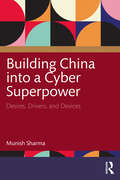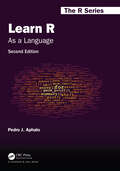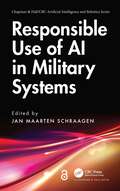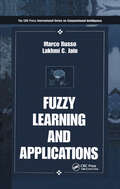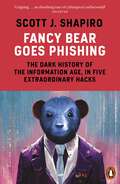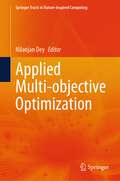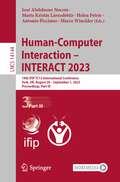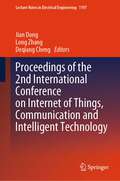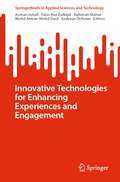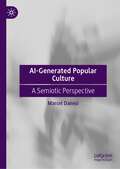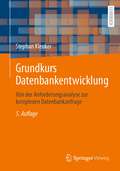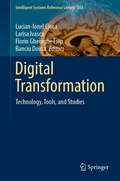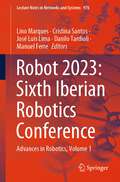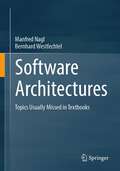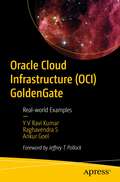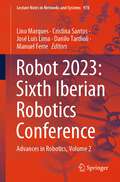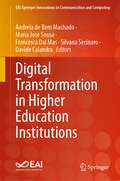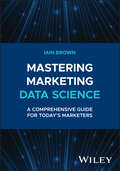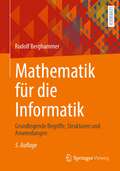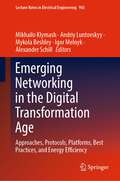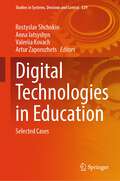- Table View
- List View
Building China into a Cyber Superpower: Desires, Drivers, and Devices
by Munish SharmaThis book provides a comprehensive look into China’s emerging cyberspace strategy. It highlights the prime drivers of China’s desire to be a cyber superpower and discusses the ways in which China is turning resources into cyber power.The book analyses China’s domestic cyber policy initiatives, strategy documents, censorship measures, and the rationale behind its strong advocacy for sovereignty in cyberspace. It examines China’s position on the prominent issues of cyberspace governance, norms and security in cyberspace, and key diplomatic initiatives. The book also discusses next-generation networks, artificial intelligence, quantum information sciences, and cyber warfare.An important contribution to the study of China’s cyber policy, the book will be of interest to students and researchers of international relations,Chinese digitalisation, security studies, Chinese politics, international security, Chinese foreign policy, and Chinese economy. It will also be useful to the policymakers and corporate professionals engaged with China’s digital sphere.
Learn R: As a Language (Chapman & Hall/CRC The R Series)
by Pedro J. AphaloLearning a computer language like R can be either frustrating, fun or boring. Having fun requires challenges that wake up the learner’s curiosity but also provide an emotional reward for overcoming them. The book is designed so that it includes smaller and bigger challenges, in what I call playgrounds, in the hope that all readers will enjoy their path to R fluency. Fluency in the use of a language is a skill that is acquired through practice and exploration. For students and professionals in the biological sciences, humanities and many applied fields, recognizing the parallels between R and natural languages should help them feel at home with R. The approach I use is similar to that of a travel guide, encouraging exploration and describing the available alternatives and how to reach them. The intention is to guide the reader through the R landscape of 2024 and beyond.What is new in the second edition? Text expanded by more than 25% to include additional R features and gentler and more detailed explanations Contains 24 new diagrams and flowcharts, seven new tables, and revised text and code examples for clarity All three indexes were expanded, and answers to 28 frequently asked questions added What will you find in this book? Programming concepts explained as they apply to current R Emphasis on the role of abstractions in programming Few prescriptive rules—mostly the author’s preferences together with alternatives Presentation of the R language emphasizing the “R way of doing things” Tutoring for “programming in the small” using scripts for data analysis Explanation of the differences between R proper and extensions for data wrangling The grammar of graphics is described as a language for the construction of data visualisations Examples of data exchange between R and the foreign world using common file formats Coaching to become an independent R user, capable of writing original scripts and solving future challenges
Learn R: As a Language (Chapman & Hall/CRC The R Series)
by Pedro J. AphaloLearning a computer language like R can be either frustrating, fun or boring. Having fun requires challenges that wake up the learner’s curiosity but also provide an emotional reward for overcoming them. The book is designed so that it includes smaller and bigger challenges, in what I call playgrounds, in the hope that all readers will enjoy their path to R fluency. Fluency in the use of a language is a skill that is acquired through practice and exploration. For students and professionals in the biological sciences, humanities and many applied fields, recognizing the parallels between R and natural languages should help them feel at home with R. The approach I use is similar to that of a travel guide, encouraging exploration and describing the available alternatives and how to reach them. The intention is to guide the reader through the R landscape of 2024 and beyond.What is new in the second edition? Text expanded by more than 25% to include additional R features and gentler and more detailed explanations Contains 24 new diagrams and flowcharts, seven new tables, and revised text and code examples for clarity All three indexes were expanded, and answers to 28 frequently asked questions added What will you find in this book? Programming concepts explained as they apply to current R Emphasis on the role of abstractions in programming Few prescriptive rules—mostly the author’s preferences together with alternatives Presentation of the R language emphasizing the “R way of doing things” Tutoring for “programming in the small” using scripts for data analysis Explanation of the differences between R proper and extensions for data wrangling The grammar of graphics is described as a language for the construction of data visualisations Examples of data exchange between R and the foreign world using common file formats Coaching to become an independent R user, capable of writing original scripts and solving future challenges
Responsible Use of AI in Military Systems (Chapman & Hall/CRC Artificial Intelligence and Robotics Series)
by Jan Maarten SchraagenArtificial Intelligence (AI) is widely used in society today. The (mis)use of biased data sets in machine learning applications is well‑known, resulting in discrimination and exclusion of citizens. Another example is the use of non‑transparent algorithms that can’t explain themselves to users, resulting in the AI not being trusted and therefore not being used when it might be beneficial to use it.Responsible Use of AI in Military Systems lays out what is required to develop and use AI in military systems in a responsible manner. Current developments in the emerging field of Responsible AI as applied to military systems in general (not merely weapons systems) are discussed. The book takes a broad and transdisciplinary scope by including contributions from the fields of philosophy, law, human factors, AI, systems engineering, and policy development.Divided into five sections, Section I covers various practical models and approaches to implementing military AI responsibly; Section II focuses on liability and accountability of individuals and states; Section III deals with human control in human‑AI military teams; Section IV addresses policy aspects such as multilateral security negotiations; and Section V focuses on ‘autonomy’ and ‘meaningful human control’ in weapons systems.Key Features: Takes a broad transdisciplinary approach to responsible AI Examines military systems in the broad sense of the word Focuses on the practical development and use of responsible AI Presents a coherent set of chapters, as all authors spent two days discussing each other’s work This book provides the reader with a broad overview of all relevant aspects involved with the responsible development, deployment and use of AI in military systems. It stresses both the advantages of AI as well as the potential downsides of including AI in military systems.
Responsible Use of AI in Military Systems (Chapman & Hall/CRC Artificial Intelligence and Robotics Series)
by Jan Maarten SchraagenArtificial Intelligence (AI) is widely used in society today. The (mis)use of biased data sets in machine learning applications is well‑known, resulting in discrimination and exclusion of citizens. Another example is the use of non‑transparent algorithms that can’t explain themselves to users, resulting in the AI not being trusted and therefore not being used when it might be beneficial to use it.Responsible Use of AI in Military Systems lays out what is required to develop and use AI in military systems in a responsible manner. Current developments in the emerging field of Responsible AI as applied to military systems in general (not merely weapons systems) are discussed. The book takes a broad and transdisciplinary scope by including contributions from the fields of philosophy, law, human factors, AI, systems engineering, and policy development.Divided into five sections, Section I covers various practical models and approaches to implementing military AI responsibly; Section II focuses on liability and accountability of individuals and states; Section III deals with human control in human‑AI military teams; Section IV addresses policy aspects such as multilateral security negotiations; and Section V focuses on ‘autonomy’ and ‘meaningful human control’ in weapons systems.Key Features: Takes a broad transdisciplinary approach to responsible AI Examines military systems in the broad sense of the word Focuses on the practical development and use of responsible AI Presents a coherent set of chapters, as all authors spent two days discussing each other’s work This book provides the reader with a broad overview of all relevant aspects involved with the responsible development, deployment and use of AI in military systems. It stresses both the advantages of AI as well as the potential downsides of including AI in military systems.
Fuzzy Learning and Applications (International Series on Computational Intelligence #19)
by Marco RussoWith low computational complexity and relatively short development time, Fuzzy Logic is an indispensable tool for engineering applications. The field is growing at an unprecedented rate, and there is a need for a book that describes essential tools, applications, examples, and perspectives in the field of fuzzy learning. The editors of Fuzzy Learni
Fuzzy Learning and Applications (International Series on Computational Intelligence)
by Marco RussoWith low computational complexity and relatively short development time, Fuzzy Logic is an indispensable tool for engineering applications. The field is growing at an unprecedented rate, and there is a need for a book that describes essential tools, applications, examples, and perspectives in the field of fuzzy learning. The editors of Fuzzy Learni
Fancy Bear Goes Phishing: The Dark History of the Information Age, in Five Extraordinary Hacks
by Scott ShapiroHacking, espionage, war and cybercrime as you've never read about them beforeFancy Bear was hungry. Looking for embarrassing information about Hillary Clinton, the elite hacking unit within Russian military intelligence broke into the Democratic National Committee network, grabbed what it could, and may have contributed to the election of Donald Trump.Robert Morris was curious. Experimenting one night, the graduate student from Cornell University released "the Great Worm" and became the first person to crash the internet.Dark Avenger was in love. To impress his crush, the Bulgarian hacker invented the first mutating computer virus-engine and nearly destroyed the anti-virus industry.Why is the internet so insecure? How do hackers exploit its vulnerabilities? Fancy Bear Goes Phishing tells the stories of five great hacks, their origins, motivations and consequences. As well as Fancy Bear, Robert Morris and Dark Avenger, we meet Cameron Lacroix, a sixteen-year-old from South Boston, who hacked Paris Hilton's cell phone because he wanted to be famous and Paras Jha, a Rutgers undergraduate, who built a giant botnet designed to get him out of his calculus exam and disrupt the online game Minecraft, but which almost destroyed the internet in the process. Scott Shapiro's five stories demonstrate that computer hacking is not just a tale of technology, but of human beings.Yet as Shapiro shows, hackers do not just abuse computer code - they exploit the philosophical principles of computation: the very features that make computers possible also make hacking possible. He explains how our information society works, the ways our data is stored and manipulated, and why it is so subject to exploitation. Both intellectual romp and dramatic true-crime narrative, Fancy Bear Goes Phishing exposes the secrets of the digital age.
Applied Multi-objective Optimization (Springer Tracts in Nature-Inspired Computing)
by Nilanjan DeyThe book explains basic ideas behind several kinds of applied multi-objective optimization and shows how it will be applied in practical contexts in the domain of healthcare, engineering design, and manufacturing. The book discusses how meta-heuristic algorithms are successful in resolving challenging, multi-objective optimization issues in various disciplines, including engineering, economics, medical and environmental management. The topic is useful for graduates, researchers and lecturers in optimization, engineering, management science and computer science.
Human-Computer Interaction – INTERACT 2023: 19th IFIP TC13 International Conference, York, UK, August 28 – September 1, 2023, Proceedings, Part III (Lecture Notes in Computer Science #14144)
by José Abdelnour Nocera Marta Kristín Lárusdóttir Helen Petrie Antonio Piccinno Marco WincklerThe four-volume set LNCS 14442 -14445 constitutes the proceedings of the 19th IFIP TC 13 International Conference on Human-Computer Interaction, INTERACT 2023, held in York, UK, in August/September 2023. The 71 full papers and 58 short papers included in this book were carefully reviewed and selected from 406 submissions. They were organized in topical sections as follows: 3D Interaction; Accessibility; Accessibility and Aging; Accessibility for Auditory/Hearing Disabilities; Co-Design; Cybersecurity and Trust; Data Physicalisation and Cross-device; Eye-Free, Gesture Interaction and Sign Language; Haptic interaction and Healthcare applications; Self-Monitoring; Human-Robot Interaction; Information Visualization; Information Visualization and 3D Interaction; Interacting with Children; Interaction with Conversational Agents; Methodologies for HCI; Model-Based UI Design and Testing; Montion Sickness, Stress and Risk perception in 3D Environments and Multisensory interaction; VR experiences; Natural Language Processing and AI Explainability; Online Collaboration and Cooperative work; Recommendation Systems and AI Explainability; Social AI; Social and Ubiquitous Computing; Social Media and Digital Learning; Understanding Users and Privacy Issues; User movement and 3D Environments; User Self-Report; User Studies; User Studies, Eye-Tracking, and Physiological Data; Virtual Reality; Virtual Reality and Training; Courses; Industrial Experiences; Interactive Demonstrations; Keynotes; Panels; Posters; and Workshops.
Proceedings of the 2nd International Conference on Internet of Things, Communication and Intelligent Technology (Lecture Notes in Electrical Engineering #1197)
by Jian Dong Long Zhang Deqiang ChengThis conference discussed the application of communication and IoT engineering in the era of smart technologies from the perspective of disciplinary integration, combining the theory and relevant algorithms of IoT and smart technologies. The book encompasses the entire spectrum of IoT solutions, from IoT to cybersecurity. It explores communication systems, including sixth generation (6G) mobile, D2D and M2M communications. It also focuses on intelligent technologies, especially information systems modeling and simulation. In addition, it explores the areas of pervasive computing, distributed computing, high performance computing, pervasive and mobile computing, and cloud computing.
Innovative Technologies for Enhancing Experiences and Engagement (SpringerBriefs in Applied Sciences and Technology)
by Azman Ismail Fatin Nur Zulkipli Rahimah Mahat Mohd Amran Mohd Daril Andreas ÖchsnerThe book showcases how the technologies are transforming entertainment, education, and professional training, offering readers real-world examples of their applications. "Innovative Technologies for Enhancing Experiences and Engagement" is an enlightening guide that reveals how emerging technologies are shaping our world, offering insights into the evolving digital landscape and inspiring a future of more personalized, immersive, and engaging experiences.
AI-Generated Popular Culture: A Semiotic Perspective
by Marcel DanesiThis book gives a general overview of Artificial Intelligence as it is impacting on the world of the arts and culture. What is AI-generated pop culture? What does a movie, a musical work, a novel, or song created entirely by a generative AI imply in terms of our notions of creativity? What is the semiotic dynamic (the meaning-making impulse that humans imprint in sign and textual forms) that is involved in an AI-produced work? No comprehensive treatment exists of the profound implications that AI-generated pop culture entails, including how it might affect cultural evolution and how we interpret artistic artifacts. Such a treatment is critical at this moment, and this book aims to fill this gap.
Grundkurs Datenbankentwicklung: Von der Anforderungsanalyse zur komplexen Datenbankanfrage
by Stephan KleukerMit diesem Buch erhalten Studierende einen kompakten und praxisorientierten Einstieg, mit dem sie bereits früh im Studium sehr gut zurechtkommen. Die verschiedenen Phasen einer Datenbankentwicklung werden mit ihren Vorgehensweisen, Konzepten und möglichen Problemquellen vorgestellt. Gerade die Anforderungsanalyse und die Möglichkeit zur Erstellung mächtiger SQL-Anfragen werden als besonders praxisrelevante Aspekte betont. Durch die im zweiten Teil detailliert vorgestellte Integration von Datenbanken in die umgebende Software sind Studierende nach der Lektüre in der Lage, in Praxisprojekten erfolgreich mitzuarbeiten. Das Buch deckt inhaltlich eine Einführungsvorlesung vollständig ab. Die 5. Auflage wurde um das Thema JPA (Objekt-Relationale-Persistenz), Trigger in Java ergänzt. Zusätzlich werden Unterschiede zwischen Oracle, Maria DB, SQLite und Apache Derby erläutert. Neben vielen kleinen Beispielen zur Verdeutlichung einzelner Aspekte wird ein durchgehendes Beispiel genutzt. Alle Kapitel schließen mit Wiederholungsfragen und Übungsaufgaben, deren Lösungen online zum Download zur Verfügung stehen.
Digital Transformation: Technology, Tools, and Studies (Intelligent Systems Reference Library #253)
by Lucian-Ionel Cioca Larisa Ivascu Florin Gheorghe Filip Banciu DoinaThis book presents a multidisciplinary approach to digital transformation process of organizational transformation, offering support throughout the implementation process to all those interested. The digital transformation (DT) is a priority for many companies in the context of technological evolution. The use of appropriate tools, methodologies, methods, approaches, and techniques for DT, depending on the organizational characteristics, can contribute to a complete approach to organizational processes and to their efficiency. Digital transformation involves the adoption and use of new digital technologies to develop new products and services, modify existing ones and develop new business models to increase efficiency, productivity, and competitiveness. Starting from marketing to culture and education to health, automotive, engineering, mobility and human resources and others, it is addressed to professionals, practitioners, researchers, students, and other interested parties.
Robot 2023: Advances in Robotics, Volume 1 (Lecture Notes in Networks and Systems #976)
by Lino Marques Cristina Santos José Luís Lima Danilo Tardioli Manuel FerreThis text will be replaced by the correct backcovertext / informationtext as soon as we get it.
Software Architectures: Topics Usually Missed in Textbooks
by Manfred Nagl Bernhard WestfechtelThis textbook concentrates on processes, activities and results related to software architectures. It describes the separation of architecture artefacts corresponding to their nature, their logical or their modeling level on one hand and at the same time emphasizes their integration based on their mutual relations. Design or development processes demand for integration, as different artifacts must be elaborated, which are mutually dependent and need to be in a consistent form. The book is structured in four parts. The introductory Part I deals with the relevance of architectures, the central role of the design subprocess both in development or maintenance, and the importance of the decisions and artefacts in the overall result. Another topic is the spectrum of views an architecture language has to offer, and that there are different architectures to be regarded, from abstract and static to detailed, technical, and specific. Part II then discusses “important topics” onthe architecture level. It deals with adaptability especially for embedded systems, with integrating styles/ pattern notations, with different reuse forms and how to find them, with the role of architectures for integrating different existing systems, and with reverse and reengineering of legacy systems. Next, Part III covers architecture modeling and its relation to surrounding activities, as well as architectures to surrounding other results. The single chapters are on transformation between requirements and architectures, architectures and programming, architectures and project management and organization, as well as architectures and their relations to quality assurance or documentation. Eventually, Part IV summarizes the main messages and presents open problems, both for every single chapter and across chapters. Every chapter focuses on a specific problem it addresses, a question it answers, the attention it demands, a message it conveys, and further open questions it raises. The chapters are mostly independent, which implies a certain redundancy, yet it allows lecturers (and their students) to either use the book as the basis of teaching software architecture or design, or to just pick those aspects that need special attention in a more advanced course.
Oracle Cloud Infrastructure (OCI) GoldenGate: Real-world Examples
by Y V Ravi Kumar Raghavendra S Ankur GoelThis book focuses on the utilization of GoldenGate Services (GGS) in conjunction with a microservices architecture on the Oracle cloud (OCI), primarily for data migration and integration across various data sources and targets.The book begins with a practical example of utilizing GGS on a Marketplace VM, progressively advancing to in-depth discussions on implementing GoldenGate as a Service on OCI. The book offers illustrative guides for data replication between RDBMSs (such as Oracle, Postgres, and big data targets such as Kafka). Additionally, it explores monitoring techniques using Enterprise Manager and Grafana dashboards. A comparative analysis is presented between traditional VM-based GoldenGate installations and the OCI service model. Special attention is given to Zero Downtime Migration (ZDM) and leveraging GGS for database migration from on-premises to OCI. Some chapters address multi-cloud replication using OCI GGS and include real-life case studies.By the end of this book you will have gained comprehensive insights into the architectural design of GoldenGate Services and will be adept at replicating data using GGS, enabling you to replicate setups in your own environments.What You Will LearnSet up GoldenGate Services for high availability (HA), disaster recovery (DR), migration of data to cloud, and moving data into the data lake or lakehousePerform logical migration of data to the cloud using the ZDM tool (ZDM uses GoldenGate internally).Replicate data to big data targetsMonitor GGS using Enterprise Manager and GrafanaReplicate data in a multi-cloud environment Who This Book Is ForOracle database administrators who want to replicate data or use Oracle GoldenGate Services for migration and setup of high availability (HA) and disaster recovery (DR); and data engineers who want tobuild the data warehouse, data lake, data lakehouse to push data in near real-time
Robot 2023: Advances in Robotics, Volume 2 (Lecture Notes in Networks and Systems #978)
by Lino Marques Cristina Santos José Luís Lima Danilo Tardioli Manuel FerreThis book contains a selection of papers accepted for presentation and discussion at ROBOT2023, the Sixth Iberian Robotics Conference, held in the University of Coimbra, Coimbra, Portugal, during November 22nd-24th, 2023. ROBOT2023 is part of a series of conferences that are jointly organized by Sociedade Portuguesa de Robótica (SPR) / Portuguese Society for Robotics and by Sociedad Española para la Investigación y Desarrollo en Robótica (SEIDROB) / Spanish Society for Research and Development in Robotics. These conferences, now occurring with a yearly periodicity, provide a forum to roboticists mostly from Iberia, but also from other parts of the world, to present and discuss their research results, new developments, and applications in the field of Robotics. The volume 1 of this book contains 45 papers addressing fundamental aspects of mobile robotics and robot manipulation while volume 2 contains 45 papers covering the application of robotics in different domains and environments.
Digital Transformation in Higher Education Institutions (EAI/Springer Innovations in Communication and Computing)
by Andreia de Bem Machado Maria José Sousa Francesca Dal Mas Silvana Secinaro Davide CalandraThis book analyzes digital technologies being used in the teaching-learning process. The authors show how the use of AI in higher education can provide personalized education through the automation of administrative teaching tasks, software programs that favor the detection of topics that need reinforcement in the classroom, the guidance and support of students outside the classroom, and the use of data intelligently to teach and support students. In addition, the authors show how to further personalize education with the use of augmented reality, adaptive platforms, intelligent tutor systems, Chatbots, adaptive learning, computer aided instruction, MOOCs, and robotics. The authors answer questions such as: What sustainable educational technologies can be used in the teaching-learning process; How can Blockchain technology and AI be applied in higher education; How can the metaverse be applied in virtual learning environments? The book is relevant to researchers, professionals, andstudents interested in technology and education.
Mastering Marketing Data Science: A Comprehensive Guide for Today's Marketers (Wiley and SAS Business Series)
by Iain BrownUnlock the Power of Data: Transform Your Marketing Strategies with Data Science In the digital age, understanding the symbiosis between marketing and data science is not just an advantage; it's a necessity. In Mastering Marketing Data Science: A Comprehensive Guide for Today's Marketers, Dr. Iain Brown, a leading expert in data science and marketing analytics, offers a comprehensive journey through the cutting-edge methodologies and applications that are defining the future of marketing. This book bridges the gap between theoretical data science concepts and their practical applications in marketing, providing readers with the tools and insights needed to elevate their strategies in a data-driven world. Whether you're a master's student, a marketing professional, or a data scientist keen on applying your skills in a marketing context, this guide will empower you with a deep understanding of marketing data science principles and the competence to apply these principles effectively. Comprehensive Coverage: From data collection to predictive analytics, NLP, and beyond, explore every facet of marketing data science. Practical Applications: Engage with real-world examples, hands-on exercises in both Python & SAS, and actionable insights to apply in your marketing campaigns. Expert Guidance: Benefit from Dr. Iain Brown's decade of experience as he shares cutting-edge techniques and ethical considerations in marketing data science. Future-Ready Skills: Learn about the latest advancements, including generative AI, to stay ahead in the rapidly evolving marketing landscape. Accessible Learning: Tailored for both beginners and seasoned professionals, this book ensures a smooth learning curve with a clear, engaging narrative. Mastering Marketing Data Science is designed as a comprehensive how-to guide, weaving together theory and practice to offer a dynamic, workbook-style learning experience. Dr. Brown's voice and expertise guide you through the complexities of marketing data science, making sophisticated concepts accessible and actionable.
Mastering Marketing Data Science: A Comprehensive Guide for Today's Marketers (Wiley and SAS Business Series)
by Iain BrownUnlock the Power of Data: Transform Your Marketing Strategies with Data Science In the digital age, understanding the symbiosis between marketing and data science is not just an advantage; it's a necessity. In Mastering Marketing Data Science: A Comprehensive Guide for Today's Marketers, Dr. Iain Brown, a leading expert in data science and marketing analytics, offers a comprehensive journey through the cutting-edge methodologies and applications that are defining the future of marketing. This book bridges the gap between theoretical data science concepts and their practical applications in marketing, providing readers with the tools and insights needed to elevate their strategies in a data-driven world. Whether you're a master's student, a marketing professional, or a data scientist keen on applying your skills in a marketing context, this guide will empower you with a deep understanding of marketing data science principles and the competence to apply these principles effectively. Comprehensive Coverage: From data collection to predictive analytics, NLP, and beyond, explore every facet of marketing data science. Practical Applications: Engage with real-world examples, hands-on exercises in both Python & SAS, and actionable insights to apply in your marketing campaigns. Expert Guidance: Benefit from Dr. Iain Brown's decade of experience as he shares cutting-edge techniques and ethical considerations in marketing data science. Future-Ready Skills: Learn about the latest advancements, including generative AI, to stay ahead in the rapidly evolving marketing landscape. Accessible Learning: Tailored for both beginners and seasoned professionals, this book ensures a smooth learning curve with a clear, engaging narrative. Mastering Marketing Data Science is designed as a comprehensive how-to guide, weaving together theory and practice to offer a dynamic, workbook-style learning experience. Dr. Brown's voice and expertise guide you through the complexities of marketing data science, making sophisticated concepts accessible and actionable.
Mathematik für die Informatik: Grundlegende Begriffe, Strukturen und Anwendungen
by Rudolf BerghammerMathematik für die Informatik: Dieses Buch bringt Ihnen die Grundlagen beiDieses Lehrbuch bietet eine Einführung in die grundlegenden Begriffe und Strukturen der Mathematik, welche am Anfang eines Informatikstudiums relevant sind. Weiterhin demonstriert es Anwendungen von mathematischen Konzepten und Methoden in der Informatik. Diese betreffen insbesondere formale Methoden der Programmverifikation und -entwicklung und den Entwurf von generischen Programmen. Ein spezielles Konzept mit einer leicht verständlichen Vermittlung des Stoffs, vielen Beispielen mit Rückgriffen auf die Schulmathematik und detaillierten Beweisen (verbunden mit der Erklärung des logischen Hintergrunds) erleichtert den Einstieg in die Mathematik an einer wissenschaftlichen Hochschule. Dadurch werden die Studierenden auch auf spätere Begriffe und tiefergehende Anwendungen der Mathematik in der Informatik gut vorbereitet. Die 5. Auflage erweitert den Inhalt um die Grundlagen der linearen Algebra. Die Übungsaufgaben zu den einzelnen Kapitel helfen, das Erlernte zu festigen und zu kontrollieren. Zahlreiche Lösungsvorschläge am Ende des Buchs ermöglichen die Überprüfung der eigenen Lösungen.Der InhaltMengentheoretische Grundlagen • Logische Grundlagen • Allgemeine direkte Produkte und Datenstrukturen • Mathematische Beweise • Spezifikation und Programmverifikation • Spezielle Funktionen • Spezielle Relationen und gerichtete Graphen • Elementare Kombinatorik und ungerichtete Graphen • Diskrete Wahrscheinlichkeitstheorie • Generische Programmierung • Grundbegriffe algebraischer Strukturen • Formale Einführung der natürlichen Zahlen - Grundbegriffe der linearen AlgebraMit diesem Buch gelingt der Einstieg ins Informatik-StudiumMit diesem Buch schaffen Sie eine solide Basis für die Mathematikausbildung im Rahmen desInformatikstudiums. Zudem sind Sie durch die vorgestellten Problemstellungen in der Lage, selbstständig mathematische Konzepte und Methoden anzuwenden. Zielgruppen dieses Buchs über Mathematik in der Informatik sind Bachelor-Studierende in den ersten Studiensemestern folgender Fachbereiche:InformatikMathematikIngenieurwissenschaften
Emerging Networking in the Digital Transformation Age: Approaches, Protocols, Platforms, Best Practices, and Energy Efficiency (Lecture Notes in Electrical Engineering #965)
by Mikhailo Klymash Andriy Luntovskyy Mykola Beshley Igor Melnyk Alexander SchillThis book covers a range of leading-edge topics. It is suitable for teaching specialists for advanced lectures in the domains of systems architecture and distributed platforms. Furthermore, it serves as a basis for undergraduates as well as an inspiration for interesting postgraduates, looking for new challenges. It addresses a holistic view of QoS, which becomes nowadays via Digital Transformations less technically and more socially driven. This includes IoT, energy efficiency, secure transactions, blockchains, and smart contracting. Under the term Emerging Networking (EmN), we cover the steadily growing diversity of smart mobile and robotic apps and unmanned scenarios (UAV). EmN supports distributed intelligence across the combined mobile, wireless, and fixed networks in the edge-to-cloud continuum. The 6G driving factors and potentials in the mid-term are examined. Operative (emergency) networking, which assists rescue troops at sites, also belongs to the above-mentionedproblems. The EmN architecture includes the components of SDN, blockchain, and AI with efficient slicing and cloud support. The design peculiarities in dynamically changing domains, such as Smart Shopping/Office/Home, Context-Sensitive Intelligent apps, are discussed. Altogether, the provided content is technically interesting while still being rather practically oriented and therefore straightforward to understand. This book originated from the close cooperation of scientists from Germany, Ukraine, Israel, Switzerland, Slovak Republic, Poland, Czech Republic, South Korea, China, Italy, North Macedonia, Azerbaijan, Kazakhstan, France, Latvia, Greece, Romania, USA, Finland, Morocco, Ireland, and the United Kingdom. We wish all readers success and lots of inspiration from this useful book!
Digital Technologies in Education: Selected Cases (Studies in Systems, Decision and Control #529)
by Rostyslav Shchokin Anna Iatsyshyn Valeriia Kovach Artur ZaporozhetsAmong the technologies that significantly change the modern world of human existence, it is worth mentioning, first of all, digital technologies. These technologies are actively and relentlessly implemented and integrated into all spheres of human activity and society, becoming a powerful catalyst and a determining source of social development. According to such a scenario of development, society acquires the features of digital, thus defining digital technologies as its leading technology. This process is called the digital transformation of society. The wide use of digital technologies to provide free access to information and knowledge is a basic principle of the digital society. Digital society significantly changes traditional ideas about work, education, culture, communication, social and political life. The development of citizens' digital culture is the main condition for the successful construction of a digital society. Therefore, it is important to carry out scientific research and targeted training to improve the qualifications of specialists in various branches of the economy, in particular, educators and scientists to acquire digital competence. After all, these specialists are key figures in ensuring the process of digitalization of education and science. The book presents various aspects of the digital transformation of education and science. A comprehensive view of the current state and prospects of the use of digital technologies for education and science is provided. The experience of using digital technologies and tools for training and improving the qualifications of specialists of various specialties, as well as for the preparation of future PhDs, is described. The book is addressed to education workers, managers, scientists, graduate students, librarians, and all those who are interested in the process of digital transformation of education and science.
